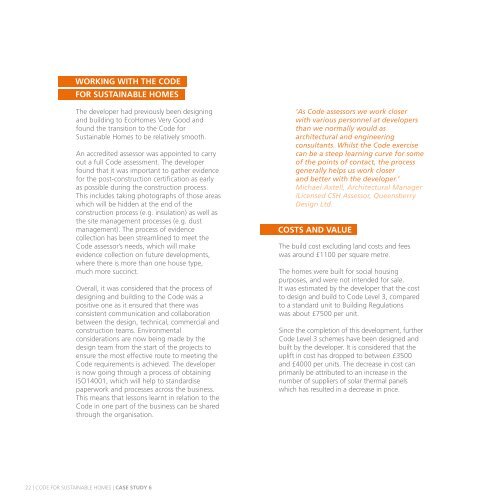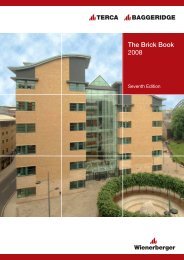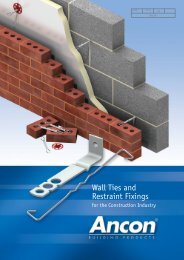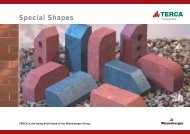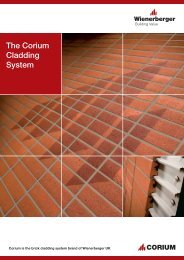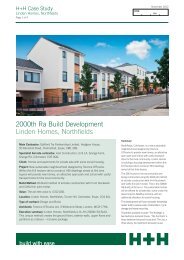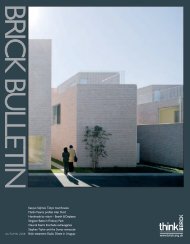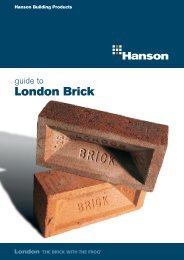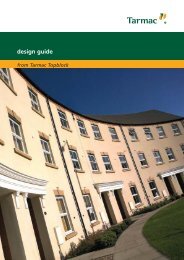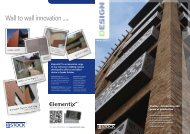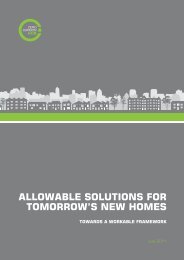Code for sustainable homes: case studies volume 2 - Gov.uk
Code for sustainable homes: case studies volume 2 - Gov.uk
Code for sustainable homes: case studies volume 2 - Gov.uk
You also want an ePaper? Increase the reach of your titles
YUMPU automatically turns print PDFs into web optimized ePapers that Google loves.
Working with the <strong>Code</strong><br />
<strong>for</strong> Sustainable Homes<br />
The developer had previously been designing<br />
and building to EcoHomes Very Good and<br />
found the transition to the <strong>Code</strong> <strong>for</strong><br />
Sustainable Homes to be relatively smooth.<br />
An accredited assessor was appointed to carry<br />
out a full <strong>Code</strong> assessment. The developer<br />
found that it was important to gather evidence<br />
<strong>for</strong> the post-construction certification as early<br />
as possible during the construction process.<br />
This includes taking photographs of those areas<br />
which will be hidden at the end of the<br />
construction process (e.g. insulation) as well as<br />
the site management processes (e.g. dust<br />
management). The process of evidence<br />
collection has been streamlined to meet the<br />
<strong>Code</strong> assessor’s needs, which will make<br />
evidence collection on future developments,<br />
where there is more than one house type,<br />
much more succinct.<br />
Overall, it was considered that the process of<br />
designing and building to the <strong>Code</strong> was a<br />
positive one as it ensured that there was<br />
consistent communication and collaboration<br />
between the design, technical, commercial and<br />
construction teams. Environmental<br />
considerations are now being made by the<br />
design team from the start of the projects to<br />
ensure the most effective route to meeting the<br />
<strong>Code</strong> requirements is achieved. The developer<br />
is now going through a process of obtaining<br />
ISO14001, which will help to standardise<br />
paperwork and processes across the business.<br />
This means that lessons learnt in relation to the<br />
<strong>Code</strong> in one part of the business can be shared<br />
through the organisation.<br />
‘As <strong>Code</strong> assessors we work closer<br />
with various personnel at developers<br />
than we normally would as<br />
architectural and engineering<br />
consultants. Whilst the <strong>Code</strong> exercise<br />
can be a steep learning curve <strong>for</strong> some<br />
of the points of contact, the process<br />
generally helps us work closer<br />
and better with the developer.’<br />
Michael Axtell, Architectural Manager<br />
/Licensed CSH Assessor, Queensberry<br />
Design Ltd.<br />
COSTS AND VALUE<br />
The build cost excluding land costs and fees<br />
was around £1100 per square metre.<br />
The <strong>homes</strong> were built <strong>for</strong> social housing<br />
purposes, and were not intended <strong>for</strong> sale.<br />
It was estimated by the developer that the cost<br />
to design and build to <strong>Code</strong> Level 3, compared<br />
to a standard unit to Building Regulations<br />
was about £7500 per unit.<br />
Since the completion of this development, further<br />
<strong>Code</strong> Level 3 schemes have been designed and<br />
built by the developer. It is considered that the<br />
uplift in cost has dropped to between £3500<br />
and £4000 per units. The decrease in cost can<br />
primarily be attributed to an increase in the<br />
number of suppliers of solar thermal panels<br />
which has resulted in a decrease in price.<br />
22 | CODE FOR SUSTAINABLE HOMES | CASE STUDY 6


